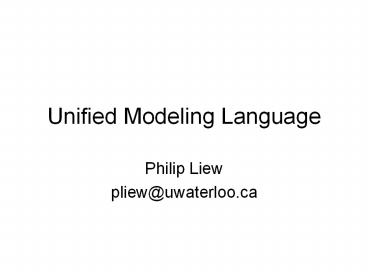Unified Modeling Language - PowerPoint PPT Presentation
1 / 17
Title:
Unified Modeling Language
Description:
Unified Modeling Language Philip Liew pliew_at_uwaterloo.ca UML Overview Standard defined by Object Management Group (www.omg.org) Current version at 1.5 Class Diagrams ... – PowerPoint PPT presentation
Number of Views:197
Avg rating:3.0/5.0
Title: Unified Modeling Language
1
Unified Modeling Language
- Philip Liew
- pliew_at_uwaterloo.ca
2
UML Overview
- Standard defined by Object Management Group
(www.omg.org) - Current version at 1.5
3
Class Diagrams
- Class diagrams consist of several classes
connected with relationships - Representation of a class
4
Class Diagram
5
Convention
- Name of class is a word with initial upper case
letter - Capitalize first letter of every word in name
- Name of attributes is lower case letter
- Capitalize first letter of every word other than
first - Operations have same naming schemes as attributes
- Brackets include parameter operation works on
6
Deriving Classes
- Nouns within requirement become classes
- Verbs become operations
- Nouns related to class nouns will become
attributes
7
Associations
- In the form of a line between two objects
- Name of association just above line
- Role presented next to class near association
- Dashed line represents constraint
8
Associations
- Multiplicity represents number of objects from
one class that relate with a number of objects in
an associated class
9
Inheritance Generalization
- Represented by a triangle
- Abstract class indicated by italics
10
Aggregation
- Components and Class represent a part-whole
relationship - Composite is a strong form of aggregation
- Components in a composite can be part of only one
whole
11
Class Visibility
- Attributes and operations have three levels of
visibility - Public Level usability extends to other classes
() - Protected Level usability open only to inherited
classes () - Private Level Only original class can use
attribute or operation (-)
12
Example
- Suppose that you're writing a document in
Microsoft Word for example. You can start typing
a new document, or open an existing one. You type
a text by using your keyboard. - Every document consists of several pages, and
every page consists of header, document's body
or/and footer. In header and footer you may add
date, time, page number, file location e.t.c. - Document's body has sentences. Sentences are made
up of words and punctual signs. Words consists of
letters, numbers and/or special characters. Also
in the text you may insert pictures and tables.
Table consists of rows and columns. Every cell
from table may hold up text or pictures. - After finishing the document, user can choose to
save or to print the document.
13
Nouns
- document, text processing tool, MicrosoftWord,
text, keyboard, header, footer, document's body,
date, time, page number, location of file, page,
sentence, word, punctual sign, letter, number,
special character, picture, table, row, column,
cell, user
14
Document Class
- Every Document consists of pages
- Page is a candidate for class
15
Header and Footer
16
Text, Table, and Picture
17
Finally

